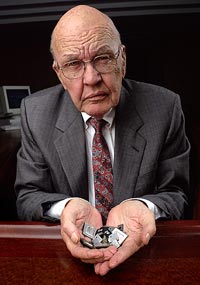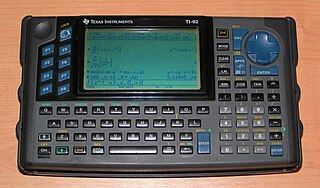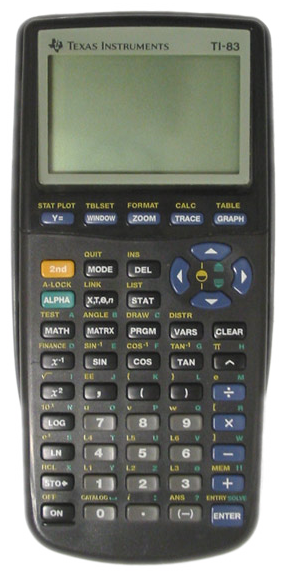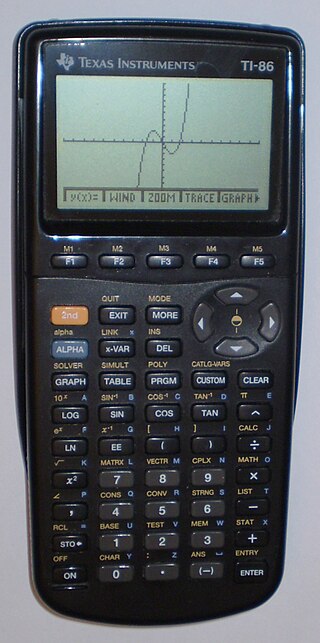Related Research Articles

An electronic calculator is typically a portable electronic device used to perform calculations, ranging from basic arithmetic to complex mathematics.


The TI-89 and the TI-89 Titanium are graphing calculators developed by Texas Instruments (TI). They are differentiated from most other TI graphing calculators by their computer algebra system, which allows symbolic manipulation of algebraic expressions—equations can be solved in terms of variables, whereas the TI-83/84 series can only give a numeric result.

Jack St. Clair Kilby was an American electrical engineer who took part in the realization of the first integrated circuit while working at Texas Instruments (TI) in 1958. He was awarded the Nobel Prize in Physics on December 10, 2000.

A graphing calculator is a handheld computer that is capable of plotting graphs, solving simultaneous equations, and performing other tasks with variables. Most popular graphing calculators are programmable calculators, allowing the user to create customized programs, typically for scientific, engineering or education applications. They have large screens that display several lines of text and calculations.

The TI-92 series of graphing calculators are a line of calculators produced by Texas Instruments. They include: the TI-92 (1995), the TI-92 II (1996), the TI-92 Plus and the Voyage 200 (2002). The design of these relatively large calculators includes a QWERTY keyboard. Because of this keyboard, it was given the status of a "computer" rather than "calculator" by American testing facilities and cannot be used on tests such as the SAT or AP Exams while the similar TI-89 can be.

The TI-83 series is a series of graphing calculators manufactured by Texas Instruments.

The Speak & Spell line is a series of electronic hand-held child computers by Texas Instruments that consisted of a TMC0280 linear predictive coding speech synthesizer, a keyboard, and a receptor slot to receive one of a collection of ROM game library modules. The first Speak & Spell was introduced at the summer Consumer Electronics Show in June 1978, making it one of the earliest handheld electronic devices with a visual display to use interchangeable game cartridges. The company Basic Fun brought back the classic Speak & Spell in 2019 with some minor changes.

The TI-86 is a programmable graphing calculator introduced in 1996 which was produced by Texas Instruments. The TI-86 uses the Zilog Z80 microprocessor. It is partially backwards-compatible with its predecessor, the TI-85.

The TI-84 Plus is a graphing calculator made by Texas Instruments which was released in early 2004. There is no original TI-84, only the TI-84 Plus, the TI-84 Plus Silver Edition models, and the TI-84 Plus CE. The TI-84 Plus is an enhanced version of the TI-83 Plus. The key-by-key correspondence is relatively the same, but the TI-84 features improved hardware. The archive (ROM) is about 3 times as large, and the CPU is about 2.5 times as fast. A USB port and built-in clock functionality were also added. The USB port on the TI-84 Plus series is USB On-The-Go compliant, similar to the next generation TI-Nspire calculator, which supports connecting to USB based data collection devices and probes, and supports device to device transfers over USB rather than over the serial link port.

The TI-81 was the first graphing calculator made by Texas Instruments. It was designed in 1990 for use in algebra and precalculus courses. Since its release, it has been superseded by a series of newer calculators: the TI-85, TI-82, TI-83, TI-86, TI-83 Plus, TI-83 Plus Silver Edition, TI-84 Plus, TI-84 Plus Silver Edition, TI-84 Plus C Silver Edition, TI-Nspire, TI-Nspire CAS, TI-84 Plus CE, and most recently, the TI-84 Plus CE Python. Most of them share the original feature set and 96×64-pixel display that began with this calculator, with the exceptions of the TI-84 Plus C Silver Edition and the TI-84 Plus CE family.

The TI-30 is a scientific calculator manufactured by Texas Instruments, the first model of which was introduced in 1976. While the original TI-30 was discontinued in 1983 after several design revisions, TI maintains the TI-30 designation as a branding for its low and mid-range scientific calculators.

The Texas Instruments LPC Speech Chips are a series of speech synthesizer digital signal processor integrated circuits created by Texas Instruments beginning in 1978. They continued to be developed and marketed for many years, though the speech department moved around several times within TI until finally dissolving in late 2001. The rights to the speech-specific subset of the MSP line, the last remaining line of TI speech products as of 2001, were sold to Sensory, Inc. in October 2001.

The TI-Nspire is a graphing calculator line made by Texas Instruments, with the first version released on 25 September 2007. The calculators feature a non-QWERTY keyboard and a different key-by-key layout than Texas Instruments's previous flagship calculators such as the TI-89 series.
In computing, a character set is a system of assigning numbers to characters so that text can be represented as a list of numbers. For example, ASCII assigns 61 to "A". As part of the design process, Texas Instruments (TI) decided to modify the base Latin-1 character set for use with its calculator interface. By adding symbols to the character set, it was possible to reduce design complexity as much more complex parsing would have to have been used otherwise.

The Texas Instruments signing key controversy resulted from Texas Instruments' (TI) response to a project to factorize the 512-bit RSA cryptographic keys needed to write custom firmware to TI devices.
The TI-1031 was a 4 function calculator manufactured by Texas Instruments. Introduced in 1981 at a price of $12, the calculator had a liquid-crystal display, weighed 1.9 ounces, and contained 24 keys.

The Little Professor is a backwards-functioning calculator designed for children ages 5 to 9. Instead of providing the answer to a mathematical expression entered by the user, it generates unsolved expressions and prompts the user for the answer.

Solar-powered calculators are hand-held electronic calculators powered by solar cells mounted on the device. They were introduced at the end of the 1970s.

The TMS1000 is a family of microcontrollers introduced by Texas Instruments in 1974.
References
- ↑ "Texas Instruments TI-1030". Datamath Calculator Museum. Archived from the original on 28 January 2021. Retrieved 30 June 2021.
- ↑ "Calculator Texas Instruments TI-1030". MyCalcDB. Archived from the original on 26 January 2018. Retrieved 30 June 2021.